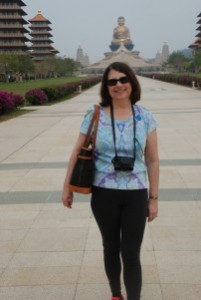
Fo Guang Shan Buddha Memorial Center, Taiwan
If you are stopping in the port of Kaohsiung, you should consider exploring Buddhist culture at southern Taiwan’s main attraction, Fo Guang Shan Buddha Memorial Center. This cultural, religious, and educational complex is a must see for anyone who wants to learn more about Buddhism. Unlike many of the Buddhist institutions that I would visit on my 2015 Asian adventure, this one is a modern facility. Construction of this mega complex near the Ganges River began in 2008 and was eventually opened to the public at the end of 2011.
We walked off the tour bus a short distance from the Welcoming Hall. As we strolled to the entry, most tourists stopped to take pictures of the elephant and lion statues that prominently stood on either side of the main door.
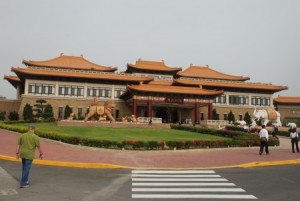
Fo Guang Shan Buddha Memorial Center
Inside there were several restaurants and souvenir shops. As some people wandered off to the restroom, our tour guide designated the nearby Starbucks as our rendezvous point. At first glance this symbol of western society seemed out of place in a Taiwanese religious institution. Even though Fo Guang Shan Buddha Memorial Center serves as the Center of Buddhism in Southern Taiwan, it clearly has become a major tourist attraction. Thus, if you like avoiding crowds, this place is not for you unless you arrive shortly after it opens.
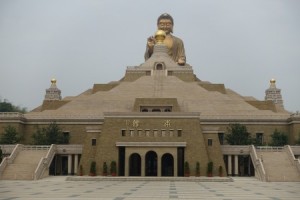
After exiting through the other side of the Welcoming Hall, I was immediately impressed by the spacious, well maintained grounds and imposing structures. One cannot miss the focal point, a massive Buddha in the horizon.
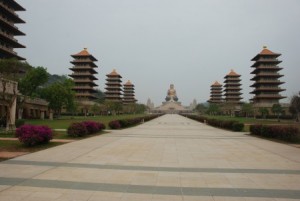
Fo Guang Shan Buddha Memorial Center, Taiwan
We followed our guide as he walked on a very long and wide sidewalk called the Great Path to Buddhahood. On each side were 4 pagodas. These structures are intended to remind people of the Noble Eightfold path. Our tour did not include a visit to any of these buildings. They were not open when we first arrived. On our walk back, some had medium sized crowds forming just outside the entrances.
The Great Path merged into the Bodhi Wisdom Concourse, an oversize courtyard in front of the Main Hall. Several Buddhist symbols were prominently displayed in this area. We looked up and on the left was the drum tower and on the right was the bell tower. Most of the temples we visited included these objects.
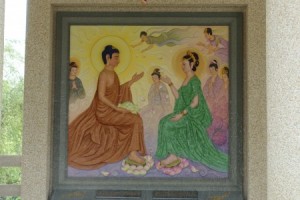
Along the outside perimeter were numerous murals that depicted Buddhist beliefs and statues of the 18 Arhats (Sanskrit for one who is worthy). In Buddhism, an Arhat is one who has gained insight into the true nature of existence and has achieved spiritual enlightenment. In Asian Buddhist temples, it is common to see statues and pictures of the Arhats in groups of 16. Over time this number was enlarged to 18 and in some instances up to 500.

Fo Guang Shan Buddha Memorial Center
Cudapanthaka was known for his slow wit and poor memory.The Buddha taught him this verse- “Sweep away the dust and remove the dirt.” Cudapanthaka believed that the environment can be cleaned with a broom while the mind is purified by wisdom. He is also remembered for this supernatural powers.
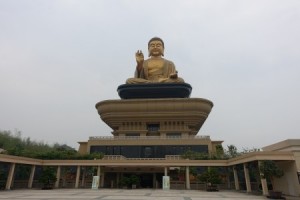
Fo Guang Shan Buddha
Memorial Center
As we walked closer to the Main Hall, the Fo Guang Big Buddha became more and more alluring as it sat peacefully atop of the multi-story building behind the hall.
As time went on we saw more and more tour groups and individuals walking in smaller groups. Most were stopping along the way to capture reminders of their visit. It was an odd mix of spirituality and tourism.
Inside the Main Hall were numerous exhibits and shrines. Our guide directed us to just a handful. One included tooth relics from Gautama Buddha, the founder of the Buddhist faith. Many Buddhist authorities question the authenticity of these relics. Had we been on our own it would have taken additional time to navigate through the facility. Unfortunately, we were prevented from taking any photos of the ornate shrines that were decorated with precious stones
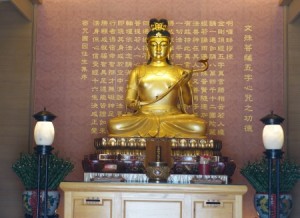
Fo Guang Shan Buddha Memorial Center
On top of the Main Hall, were four tiered structures that were labeled the Four Noble Truth Pagodas- Stupa of Vow, Stupa of Practice, Stupa of Wisdom, and Stupa of Compassion. The insides were adorned with ornate statues. See above.
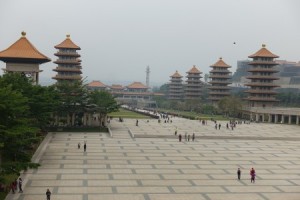
After reaching the top of the Main Hall, we had a panoramic view of this massive institution. We could look back to see the buildings between the Welcoming Hall and the Main Hall as well as take close up pictures of the Buddha.
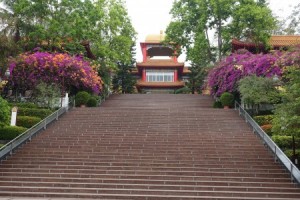
Taiwan
We returned to the bus for a short drive. A sizable number or participants waited for a golf cart while we started to climb the stairs that were bordered by more statues and beautiful flowers. Our destination was a building that had 3 golden Buddhas that were protected by oversized ornately decorated doors.
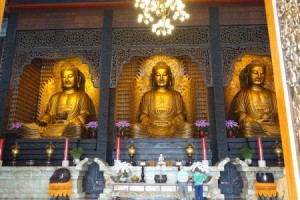
Great Buddha Land
Adjacent to this building were the grounds of the Fo Guang Shan Monastery and another place called Great Buddha Land.

Adjacent to Fo Guang Buddha Memorial Center
We could hear a bell in the distance. Suddenly, men and women dressed in long robes started to form lines. Our guide told us that the monastery students were being summoned for lunch.
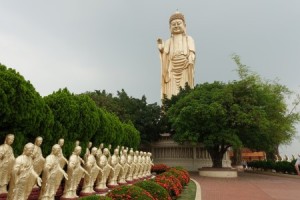
Taiwan
The centerpiece of Great Buddha Land is a giant ivory colored Buddha. As we walked toward this Buddha, we climbed up a hill. Along the way, we were able to see many smaller Buddhas and a variety of statues.
Prior to this visit, I had limited background knowledge about Buddhism. Since our Taiwanese guide had a strong accent and our group was large, too many words were lost. Even though I was unable to put everything that I saw into historical or religious context, I had a good introduction to this complex ancient culture. Through the murals and the statues, I got a small glimpse into how Buddhist religious stories lead to a philosophical understanding of life.
Related Posts
Precruise Exploration of Hong Kong
Precautions When Traveling to Third World Countries
15 Safety Tips for Women Traveling Solo
6 Tips to Promote a Healthy Cruise Experience
Sandra’s Bio
Sandra Bornstein is the author of MAY THIS BE THE BEST YEAR OF YOUR LIFE. It is available on Amazon. Sandra’s memoir highlights her living and teaching adventure in Bangalore, India. She is a licensed Colorado teacher who has taught K-12 students in the United States and abroad as well as college level courses. Sandra is married and has four adult sons. The memoir was a finalist in the Travel category for the 2013 Next Generation Indie Book Awards, the 2013 International Book Awards, the 2013 National Indie Book Excellence Awards, the 2013 USA Best Book Awards, and received an Honorable Mention award in the Multicultural Non-Fiction category for the 2013 Global ebook Awards.
Dear Sandra,
It was pleasant surprise to see your blog. Thank you very much for introducing our center!
Youlu
BMC International Team